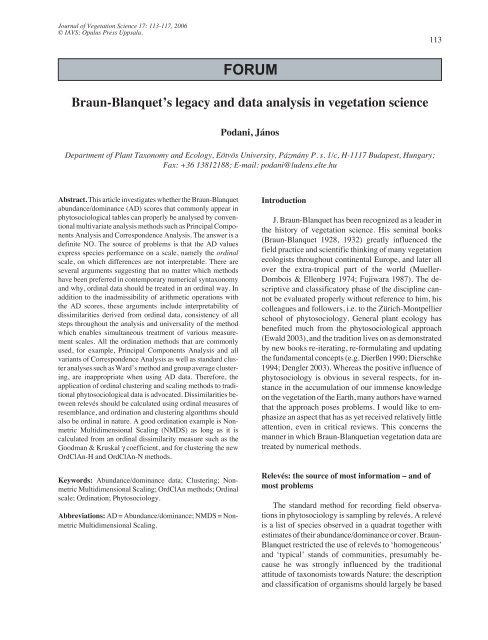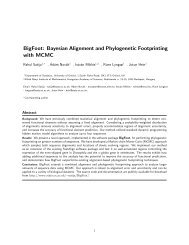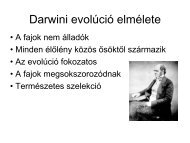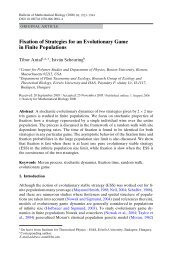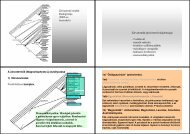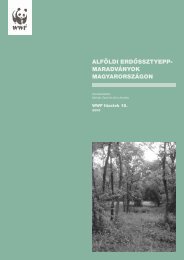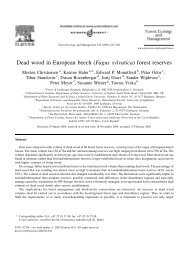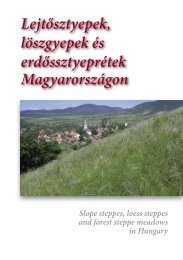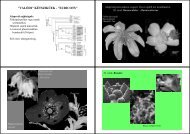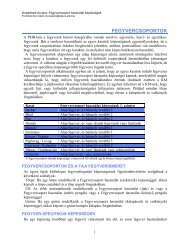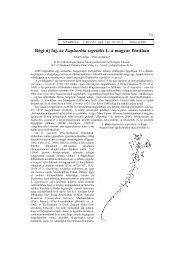Braun-Blanquet's legacy and data analysis in vegetation science
Braun-Blanquet's legacy and data analysis in vegetation science
Braun-Blanquet's legacy and data analysis in vegetation science
You also want an ePaper? Increase the reach of your titles
YUMPU automatically turns print PDFs into web optimized ePapers that Google loves.
Journal of Vegetation Science 17: 113-117, 2006<br />
© IAVS; Opulus Press Uppsala.<br />
FORUM<br />
- <strong>Braun</strong>-Blanquet’s <strong>legacy</strong> <strong>and</strong> <strong>data</strong> <strong>analysis</strong> <strong>in</strong> <strong>vegetation</strong> <strong>science</strong> - 113<br />
FORUM<br />
<strong>Braun</strong>-Blanquet’s <strong>legacy</strong> <strong>and</strong> <strong>data</strong> <strong>analysis</strong> <strong>in</strong> <strong>vegetation</strong> <strong>science</strong><br />
Podani, János<br />
Department of Plant Taxonomy <strong>and</strong> Ecology, Eötvös University, Pázmány P. s. 1/c, H-1117 Budapest, Hungary;<br />
Fax: +36 13812188; E-mail: podani@ludens.elte.hu<br />
Abstract. This article <strong>in</strong>vestigates whether the <strong>Braun</strong>-Blanquet<br />
abundance/dom<strong>in</strong>ance (AD) scores that commonly appear <strong>in</strong><br />
phytosociological tables can properly be analysed by conventional<br />
multivariate <strong>analysis</strong> methods such as Pr<strong>in</strong>cipal Components<br />
Analysis <strong>and</strong> Correspondence Analysis. The answer is a<br />
def<strong>in</strong>ite NO. The source of problems is that the AD values<br />
express species performance on a scale, namely the ord<strong>in</strong>al<br />
scale, on which differences are not <strong>in</strong>terpretable. There are<br />
several arguments suggest<strong>in</strong>g that no matter which methods<br />
have been preferred <strong>in</strong> contemporary numerical syntaxonomy<br />
<strong>and</strong> why, ord<strong>in</strong>al <strong>data</strong> should be treated <strong>in</strong> an ord<strong>in</strong>al way. In<br />
addition to the <strong>in</strong>admissibility of arithmetic operations with<br />
the AD scores, these arguments <strong>in</strong>clude <strong>in</strong>terpretability of<br />
dissimilarities derived from ord<strong>in</strong>al <strong>data</strong>, consistency of all<br />
steps throughout the <strong>analysis</strong> <strong>and</strong> universality of the method<br />
which enables simultaneous treatment of various measurement<br />
scales. All the ord<strong>in</strong>ation methods that are commonly<br />
used, for example, Pr<strong>in</strong>cipal Components Analysis <strong>and</strong> all<br />
variants of Correspondence Analysis as well as st<strong>and</strong>ard cluster<br />
analyses such as Ward’s method <strong>and</strong> group average cluster<strong>in</strong>g,<br />
are <strong>in</strong>appropriate when us<strong>in</strong>g AD <strong>data</strong>. Therefore, the<br />
application of ord<strong>in</strong>al cluster<strong>in</strong>g <strong>and</strong> scal<strong>in</strong>g methods to traditional<br />
phytosociological <strong>data</strong> is advocated. Dissimilarities between<br />
relevés should be calculated us<strong>in</strong>g ord<strong>in</strong>al measures of<br />
resemblance, <strong>and</strong> ord<strong>in</strong>ation <strong>and</strong> cluster<strong>in</strong>g algorithms should<br />
also be ord<strong>in</strong>al <strong>in</strong> nature. A good ord<strong>in</strong>ation example is Nonmetric<br />
Multidimensional Scal<strong>in</strong>g (NMDS) as long as it is<br />
calculated from an ord<strong>in</strong>al dissimilarity measure such as the<br />
Goodman & Kruskal γ coefficient, <strong>and</strong> for cluster<strong>in</strong>g the new<br />
OrdClAn-H <strong>and</strong> OrdClAn-N methods.<br />
Keywords: Abundance/dom<strong>in</strong>ance <strong>data</strong>; Cluster<strong>in</strong>g; Nonmetric<br />
Multidimensional Scal<strong>in</strong>g; OrdClAn methods; Ord<strong>in</strong>al<br />
scale; Ord<strong>in</strong>ation; Phytosociology.<br />
Abbreviations: AD = Abundance/dom<strong>in</strong>ance; NMDS = Nonmetric<br />
Multidimensional Scal<strong>in</strong>g.<br />
Introduction<br />
J. <strong>Braun</strong>-Blanquet has been recognized as a leader <strong>in</strong><br />
the history of <strong>vegetation</strong> <strong>science</strong>. His sem<strong>in</strong>al books<br />
(<strong>Braun</strong>-Blanquet 1928, 1932) greatly <strong>in</strong>fluenced the<br />
field practice <strong>and</strong> scientific th<strong>in</strong>k<strong>in</strong>g of many <strong>vegetation</strong><br />
ecologists throughout cont<strong>in</strong>ental Europe, <strong>and</strong> later all<br />
over the extra-tropical part of the world (Mueller-<br />
Dombois & Ellenberg 1974; Fujiwara 1987). The descriptive<br />
<strong>and</strong> classificatory phase of the discipl<strong>in</strong>e cannot<br />
be evaluated properly without reference to him, his<br />
colleagues <strong>and</strong> followers, i.e. to the Zürich-Montpellier<br />
school of phytosociology. General plant ecology has<br />
benefited much from the phytosociological approach<br />
(Ewald 2003), <strong>and</strong> the tradition lives on as demonstrated<br />
by new books re-iterat<strong>in</strong>g, re-formulat<strong>in</strong>g <strong>and</strong> updat<strong>in</strong>g<br />
the fundamental concepts (e.g. Dierßen 1990; Dierschke<br />
1994; Dengler 2003). Whereas the positive <strong>in</strong>fluence of<br />
phytosociology is obvious <strong>in</strong> several respects, for <strong>in</strong>stance<br />
<strong>in</strong> the accumulation of our immense knowledge<br />
on the <strong>vegetation</strong> of the Earth, many authors have warned<br />
that the approach poses problems. I would like to emphasize<br />
an aspect that has as yet received relatively little<br />
attention, even <strong>in</strong> critical reviews. This concerns the<br />
manner <strong>in</strong> which <strong>Braun</strong>-Blanquetian <strong>vegetation</strong> <strong>data</strong> are<br />
treated by numerical methods.<br />
Relevés: the source of most <strong>in</strong>formation – <strong>and</strong> of<br />
most problems<br />
The st<strong>and</strong>ard method for record<strong>in</strong>g field observations<br />
<strong>in</strong> phytosociology is sampl<strong>in</strong>g by relevés. A relevé<br />
is a list of species observed <strong>in</strong> a quadrat together with<br />
estimates of their abundance/dom<strong>in</strong>ance or cover. <strong>Braun</strong>-<br />
Blanquet restricted the use of relevés to ‘homogeneous’<br />
<strong>and</strong> ‘typical’ st<strong>and</strong>s of communities, presumably because<br />
he was strongly <strong>in</strong>fluenced by the traditional<br />
attitude of taxonomists towards Nature: the description<br />
<strong>and</strong> classification of organisms should largely be based
114 Podani, J. FORUM<br />
on the most typical-look<strong>in</strong>g plant or animal <strong>in</strong>dividuals.<br />
Furthermore, when <strong>Braun</strong>-Blanquet developed his ideas<br />
computers were not yet <strong>in</strong>vented, sampl<strong>in</strong>g theory was<br />
<strong>in</strong> an <strong>in</strong>itial stage <strong>and</strong> the use of statistical methods <strong>in</strong><br />
biology was exceptional. As a result, the relevé method<br />
is burdened by much bias, subjectivity, <strong>in</strong>consistency,<br />
arbitrar<strong>in</strong>ess, circular argumentation <strong>and</strong> large sampl<strong>in</strong>g<br />
error (cf. Podani 1984 <strong>and</strong> references there<strong>in</strong>; Feoli<br />
1984; Lepš & Had<strong>in</strong>cová 1992; Chytrý 2001; Chytrý &<br />
Otypková 2003) – a peculiar comb<strong>in</strong>ation of flaws probably<br />
unprecedented <strong>in</strong> the natural <strong>science</strong>s. We cannot<br />
blame <strong>Braun</strong>-Blanquet, of course, that he was unable to<br />
envisage all difficulties that were revealed only many<br />
decades after the approach was launched. The problems<br />
associated with sampl<strong>in</strong>g can be resolved by moderniz<strong>in</strong>g<br />
<strong>and</strong> st<strong>and</strong>ardiz<strong>in</strong>g field methods, <strong>and</strong> there are<br />
attempts <strong>in</strong> the contemporary literature to achieve this<br />
goal (Bruelheide & Chytrý 2000; Muc<strong>in</strong>a et al. 2000;<br />
Chytrý & Otypková 2003; Grabherr et al. 2003). These<br />
authors promote the use of various objective sampl<strong>in</strong>g<br />
designs <strong>and</strong> st<strong>and</strong>ardized quadrat sizes which allow<br />
generalizations to be made from relevé <strong>data</strong>.<br />
Numerical syntaxonomy<br />
Computers were <strong>in</strong>troduced <strong>in</strong>to the process<strong>in</strong>g of<br />
phytosociological <strong>data</strong> as early as the 1960s (cf. van der<br />
Maarel 1975, 1982). Transition <strong>in</strong>to the numerical phase<br />
was greatly stimulated by the <strong>in</strong>creased availability of<br />
computer program packages <strong>and</strong> personal computers,<br />
<strong>and</strong> the appearance of important books (e.g. Whittaker<br />
1973; Orlóci 1978). Classification <strong>and</strong> ord<strong>in</strong>ation of<br />
relevé <strong>data</strong> became an everyday practice of <strong>vegetation</strong><br />
scientists. The paradigm shift towards numerical <strong>analysis</strong><br />
was relatively straightforward, mostly because subjectivity,<br />
<strong>in</strong>consistency, <strong>and</strong> arbitrar<strong>in</strong>ess <strong>in</strong> select<strong>in</strong>g<br />
the objects of the study play no direct role <strong>in</strong> multivariate<br />
<strong>data</strong> exploration. Cluster <strong>analysis</strong> <strong>and</strong> ord<strong>in</strong>ation<br />
impose no restrictions on sampl<strong>in</strong>g conditions: any set<br />
of objects can be analysed provided that these are characterized<br />
by an appropriate set of descriptors. Furthermore,<br />
any dissimilarity matrix can be subjected to complete<br />
l<strong>in</strong>kage cluster<strong>in</strong>g or pr<strong>in</strong>cipal coord<strong>in</strong>ates <strong>analysis</strong>,<br />
for example, without violat<strong>in</strong>g any mathematical<br />
rule. Of course, sampl<strong>in</strong>g methods need to be consistent<br />
with the objectives of an <strong>in</strong>vestigation (see Kenkel et al.<br />
1989 for a review of this topic). Classification <strong>and</strong><br />
ord<strong>in</strong>ation methods do have their own limitations, of<br />
which compatibility of a procedure with the type of <strong>data</strong><br />
is of primary concern.<br />
The issue of measurement scale<br />
The basic source of computational problems is the<br />
scale on which species performance is measured with<strong>in</strong><br />
each relevé. <strong>Braun</strong>-Blanquet’s well-known abundance/<br />
dom<strong>in</strong>ance scale is r, +, 1, 2, 3, 4 <strong>and</strong> 5, quite often<br />
diluted with <strong>in</strong>termediate scores such as + - 1 or 1 - 2.<br />
Obviously, the presence of non-numbers r <strong>and</strong> + <strong>in</strong> the<br />
<strong>data</strong> immediately excludes the possibility of calculations,<br />
therefore several procedures have been suggested<br />
to convert the values to some other scale conta<strong>in</strong><strong>in</strong>g only<br />
numerals (van der Maarel 1979).<br />
These transformations overcome the non-number<br />
problem, but the newly def<strong>in</strong>ed ‘ord<strong>in</strong>al scale’ preserves<br />
a less apparent property: certa<strong>in</strong> operations with the<br />
values are strictly <strong>in</strong>admissible (Anderberg 1973). Differences,<br />
sums <strong>and</strong> ratios of possible values are not<br />
<strong>in</strong>terpretable on the ord<strong>in</strong>al scale, only the relations =<br />
<strong>and</strong> < are mean<strong>in</strong>gful, so that only the order<strong>in</strong>g of values<br />
conveys <strong>in</strong>formation. In other words, the difference<br />
between 1 <strong>and</strong> 2 is not the same as that between 3 <strong>and</strong> 4,<br />
1+2 is not equal to 3 <strong>and</strong> 1/2 is not the same as 2/4. The<br />
essence of the problem is that conventional dissimilarity<br />
functions, cluster<strong>in</strong>g <strong>and</strong> ord<strong>in</strong>ation algorithms operate<br />
via subtraction, addition <strong>and</strong> division <strong>and</strong> consequently<br />
their application to relevé <strong>data</strong> is <strong>in</strong>appropriate.<br />
It is strik<strong>in</strong>g that numerical syntaxonomic surveys<br />
analys<strong>in</strong>g <strong>Braun</strong>-Blanquet-type <strong>data</strong> completely disregard<br />
this <strong>in</strong>compatibility, although there have been a<br />
few reports recogniz<strong>in</strong>g this problem. Dale (1989), for<br />
example, discussed the possibilities of calculat<strong>in</strong>g dissimilarity<br />
based on ord<strong>in</strong>al abundance <strong>data</strong>, but his work<br />
has been overlooked almost completely. The ISI <strong>data</strong>base<br />
<strong>in</strong>cludes only two references to this important paper,<br />
while Google Scholar Search f<strong>in</strong>ds only one more document<br />
– a pa<strong>in</strong>ful <strong>in</strong>dication of general ignorance.<br />
At first glance, there appear to be several remedies.<br />
At the level of sampl<strong>in</strong>g, one could record percentage<br />
cover, biomass or counts of <strong>in</strong>dividuals, i.e., ‘quantitative<br />
<strong>data</strong>’, so as to avoid all problems mentioned above.<br />
But <strong>vegetation</strong> <strong>data</strong>bases already <strong>in</strong>clude hundreds of<br />
thous<strong>and</strong>s of relevés most of which described <strong>in</strong> terms<br />
of ord<strong>in</strong>al variables, <strong>and</strong> the jo<strong>in</strong>t evaluation of such<br />
traditional <strong>data</strong> <strong>and</strong> quantitative <strong>data</strong> would be impossible.<br />
Another solution is simplification of <strong>data</strong> to presence/absence<br />
scores whose <strong>analysis</strong> poses no computational<br />
problems. However, this implies <strong>in</strong>formation loss<br />
because the ord<strong>in</strong>al scale variables tell us more about<br />
<strong>in</strong>terspecific relationships than simple presence <strong>and</strong> absence<br />
<strong>data</strong>.<br />
A further possibility is conversion of <strong>Braun</strong>-Blanquet<br />
scores to mean values of percentage cover classes, but<br />
the arbitrar<strong>in</strong>ess <strong>and</strong> the non-systematic distortion implied<br />
<strong>in</strong> this operation are obvious. For example, if the
FORUM<br />
- <strong>Braun</strong>-Blanquet’s <strong>legacy</strong> <strong>and</strong> <strong>data</strong> <strong>analysis</strong> <strong>in</strong> <strong>vegetation</strong> <strong>science</strong> - 115<br />
AD value of 5 is replaced by 87.5%, as commonly<br />
suggested, then the new value will designate all actual<br />
cover values from 75 to 100%, thus <strong>in</strong>creas<strong>in</strong>g uncerta<strong>in</strong>ty<br />
<strong>in</strong> the <strong>data</strong> considerably.<br />
Ord<strong>in</strong>al <strong>data</strong> <strong>analysis</strong><br />
The best <strong>and</strong> mathematically correct solution of the<br />
scale problem is the use of ord<strong>in</strong>ation <strong>and</strong> classification<br />
procedures that are compatible with variables measured<br />
on the ord<strong>in</strong>al scale, that is, the application of ord<strong>in</strong>al<br />
methods of <strong>data</strong> <strong>analysis</strong>. For those not conv<strong>in</strong>ced yet by<br />
the above reason<strong>in</strong>g on <strong>in</strong>admissible arithmetic operations,<br />
I have three further arguments support<strong>in</strong>g the<br />
po<strong>in</strong>t that ord<strong>in</strong>al phytosociological <strong>data</strong> should be treated<br />
<strong>in</strong> a way other than they usually are.<br />
Argument 1: Mean<strong>in</strong>gful dissimilarity<br />
The most critical step <strong>in</strong> select<strong>in</strong>g the appropriate<br />
method is the choice of a dissimilarity coefficient which<br />
is mean<strong>in</strong>gful phytosociologically <strong>and</strong>, at the same time,<br />
compatible with ord<strong>in</strong>al <strong>data</strong>. As an example, let us<br />
consider the follow<strong>in</strong>g artificial phytosociological table<br />
for three relevés <strong>and</strong> two species:<br />
Relevés<br />
h i j<br />
Bromus erectus 1 2 4<br />
Poa bulbosa 2 1 2<br />
If we formally use the well-known Euclidean distance to<br />
measure dissimilarity, we f<strong>in</strong>d that relevés h <strong>and</strong> i are<br />
closest to each other, <strong>and</strong> then follow the pairs ij <strong>and</strong> hj,<br />
more precisely, d hi<br />
< d ij<br />
< d hj<br />
(= 1.41 < 2.23 < 3). It<br />
catches the eye, however, that <strong>in</strong> the most similar relevés<br />
we f<strong>in</strong>d a reverse relationship or ‘negative correlation’<br />
between the two species. Namely, P. bulbosa is more<br />
‘important’ than B. erectus <strong>in</strong> relevé h, whereas it is just<br />
the opposite <strong>in</strong> relevé i. Furthermore, d hi<br />
< d ij<br />
even<br />
though the two species occur <strong>in</strong> the same proportion <strong>in</strong><br />
relevés i <strong>and</strong> j. The conclusion is that Euclidean distance<br />
is mislead<strong>in</strong>g, <strong>and</strong> not only because differences are<br />
calculated between ord<strong>in</strong>al values but also due to its<br />
dim<strong>in</strong>ished ecological <strong>in</strong>terpretability! One could say<br />
that st<strong>and</strong>ardization by relevé totals provides a more<br />
<strong>in</strong>terpretable distance matrix, but this <strong>in</strong>volves addition<br />
<strong>and</strong> division, which is not permissible with such <strong>data</strong>.<br />
We need to f<strong>in</strong>d a coefficient that is compatible with<br />
ord<strong>in</strong>al scores <strong>and</strong> at the same time gives ecologically<br />
<strong>in</strong>terpretable results. The Goodman & Kruskal (1954) γ<br />
coefficient offers the simplest possibility. It counts the<br />
number of species pairs (a) that are identically ordered<br />
by the two relevés be<strong>in</strong>g compared <strong>and</strong> those that are<br />
reversely ordered (b). Then, similarity is def<strong>in</strong>ed as the<br />
ratio γ = (a–b)/(a+b) which yields 1 if all species pairs<br />
are ordered <strong>in</strong> the same way by the two relevés, <strong>and</strong> –1<br />
if the order<strong>in</strong>g is different for all species pairs. The<br />
complement of this coefficient, 1–γ, provides dissimilarities<br />
which are ordered as d ij<br />
< d hi<br />
= d hj<br />
for the<br />
artificial example above. This coefficient, however, does<br />
not use the <strong>in</strong>formation present <strong>in</strong> situations <strong>in</strong> which<br />
AD values are equal <strong>and</strong> therefore order<strong>in</strong>g of species is<br />
not possible for one or both relevés, for example,<br />
Relevés<br />
h i<br />
Carex humilis 2 1<br />
Campanula sibirica 2 0<br />
For an ecologist, this configuration is still <strong>in</strong>formative <strong>in</strong><br />
its presence/absence <strong>in</strong>formation, because these two<br />
species differ between the relevés. As an expansion of γ<br />
to <strong>in</strong>corporate this <strong>in</strong>formation, I suggested the use of a<br />
hybrid discordance measure (Podani 1997) for phytosociological<br />
<strong>data</strong> so that presence/absence still plays a<br />
role <strong>in</strong> calculat<strong>in</strong>g ord<strong>in</strong>al dissimilarity even if order<strong>in</strong>g<br />
is not possible. Accord<strong>in</strong>g to this function, the pair of C.<br />
humilis <strong>and</strong> C. sibirica <strong>in</strong>creases the dissimilarity of the<br />
two relevés. For further examples illustrat<strong>in</strong>g the behaviour<br />
of this coefficient under circumstances not exam<strong>in</strong>ed<br />
above, see App. A <strong>in</strong> Podani (2005).<br />
Argument 2: Overall consistency<br />
There is a def<strong>in</strong>ite direction of <strong>in</strong>formation flow <strong>in</strong><br />
every numerical <strong>vegetation</strong> study, from sampl<strong>in</strong>g through<br />
various steps of <strong>data</strong> <strong>analysis</strong> to display<strong>in</strong>g the f<strong>in</strong>al<br />
diagrams. In this sequence, the quality of the very first<br />
step greatly <strong>in</strong>fluences the subsequent steps, which cannot<br />
give results that are of higher quality than the start<br />
(Gill & Tipper 1978). In phytosociology, this means that<br />
once ord<strong>in</strong>al <strong>data</strong> have been recorded, all steps that<br />
follow should also be ord<strong>in</strong>al <strong>in</strong> nature. The coefficient<br />
chosen should accept ord<strong>in</strong>al <strong>data</strong>, <strong>and</strong> then cluster<strong>in</strong>g<br />
<strong>and</strong> ord<strong>in</strong>ation procedures also should consider only the<br />
order<strong>in</strong>g relationships among the coefficients (Podani<br />
2005). Application of Ward’s cluster<strong>in</strong>g strategy (<strong>in</strong>cremental<br />
sum of squares agglomeration), for example, is<br />
<strong>in</strong>appropriate for ord<strong>in</strong>al <strong>data</strong> because the existence of a<br />
Euclidean space is implied <strong>and</strong> thus the validity of all<br />
arithmetic operations is assumed. Moreover, the method<br />
is much more precise than the precision with which the<br />
<strong>data</strong> were collected. Instead of Ward’s method, a cluster<strong>in</strong>g<br />
procedure is needed which only considers the<br />
order<strong>in</strong>g of ord<strong>in</strong>al dissimilarities. To achieve this goal,<br />
I have suggested a pair of methods, OrdClAn-H for<br />
hierarchical <strong>and</strong> OrdClAn-N for non-hierarchical clas-
116 Podani, J. FORUM<br />
sifications, <strong>and</strong> made them available through the SYN-<br />
TAX 2000 program package (Podani 2001). Similar<br />
arguments hold true for ord<strong>in</strong>ation procedures: comput<strong>in</strong>g<br />
the eigenvalues <strong>in</strong> a metric ord<strong>in</strong>ation is a much<br />
more precise operation than relevé sampl<strong>in</strong>g. The most<br />
logical choice <strong>in</strong> this case is therefore Non-metric Multidimensional<br />
Scal<strong>in</strong>g (NMDS) <strong>in</strong> which only the order<strong>in</strong>g<br />
relationships of dissimilarities are <strong>in</strong>fluential, rather<br />
than their actual values, <strong>in</strong> determ<strong>in</strong><strong>in</strong>g the configuration<br />
of objects <strong>in</strong> the ord<strong>in</strong>ation (Gordon 1999).<br />
Argument 3: Universality<br />
Imag<strong>in</strong>e a situation <strong>in</strong> which relevés were made by<br />
‘Peter’ <strong>in</strong> 1966 <strong>and</strong> by ‘Paul’ <strong>in</strong> 1990 <strong>in</strong> the same study<br />
area. Assume further that different AD scales were used,<br />
<strong>Braun</strong>-Blanquet scores by ‘Peter’ <strong>and</strong> the Dom<strong>in</strong> scale<br />
by ‘Paul’. If ‘Mary’ wishes to do a comparative study<br />
later, the two <strong>data</strong> sets cannot be comb<strong>in</strong>ed <strong>and</strong> then<br />
analysed by conventional multivariate <strong>analysis</strong> methods.<br />
This is not a hypothetical possibility: Chytrý &<br />
Rafajova (2003) mention, for example, that the 54 310<br />
relevés <strong>in</strong> the Czech phytosociological <strong>data</strong>base were<br />
collected by 332 authors between 1922 <strong>and</strong> 2002, so that<br />
there is a very high chance for such <strong>data</strong> to be heterogeneous.<br />
In this case, the problem is not only the <strong>in</strong>admissibility<br />
of subtraction <strong>and</strong> addition, but also that the<br />
values have different mean<strong>in</strong>gs on the two scales. For<br />
example, 2 implies different abundances on the <strong>Braun</strong>-<br />
Blanquet <strong>and</strong> Dom<strong>in</strong> scales, therefore agreement of two<br />
relevés (one made by ‘Peter’ <strong>and</strong> the other by ‘Paul’) <strong>in</strong><br />
hav<strong>in</strong>g the same value of 2 for a given species is a<br />
mislead<strong>in</strong>g <strong>in</strong>dication of their similarity. Comparable<br />
<strong>in</strong>formation <strong>in</strong> the <strong>data</strong> obta<strong>in</strong>ed by the two scientists is<br />
conveyed only by the order<strong>in</strong>g relationships among<br />
species, even though the order<strong>in</strong>g may be f<strong>in</strong>er on one<br />
scale than on the other. From the arguments above it is<br />
clear that only ord<strong>in</strong>al procedures can correctly h<strong>and</strong>le<br />
<strong>data</strong> that are expressed on different ord<strong>in</strong>al scales, <strong>and</strong><br />
are therefore the only admissible solution <strong>in</strong> such synthetic<br />
studies. These methods allow comparisons based<br />
on a mixture of ord<strong>in</strong>al <strong>and</strong> quantitative <strong>data</strong> as well,<br />
further exp<strong>and</strong><strong>in</strong>g the utility of the ord<strong>in</strong>al approach.<br />
Conclusions<br />
In review<strong>in</strong>g the pioneer<strong>in</strong>g age of numerical<br />
syntaxonomy, Muc<strong>in</strong>a & van der Maarel (1989) concluded<br />
that pragmatic criteria, i.e. the ability to reproduce<br />
<strong>in</strong>tuitive classifications, seem to have been more<br />
important for <strong>vegetation</strong> scientists <strong>in</strong> mak<strong>in</strong>g choices<br />
among available techniques than theoretical aspects have.<br />
Undoubtedly, a human factor is always present <strong>in</strong> numerical<br />
community studies <strong>and</strong>, as Gauch (1982) put it,<br />
“sampl<strong>in</strong>g method or <strong>analysis</strong> <strong>in</strong> the first place is an art”.<br />
I agree with these authors that <strong>in</strong>terpretability, <strong>in</strong>tuitive<br />
appeal, custom, availability, simplicity <strong>and</strong> the like are<br />
relevant when judg<strong>in</strong>g the relative merits of methods,<br />
but I doubt whether the human factor deserves priority<br />
<strong>in</strong> any scientific discipl<strong>in</strong>e. This article emphasizes that<br />
mathematical admissibility, mean<strong>in</strong>gfulness of dissimilarities,<br />
consistency <strong>and</strong> universality should override<br />
any other, mostly subjective criteria. Conventional cluster<strong>in</strong>g<br />
<strong>and</strong> ord<strong>in</strong>ation procedures do not satisfy these<br />
requirements if applied to <strong>Braun</strong>-Blanquet-type <strong>data</strong><br />
types. I cannot recommend the use of methods that rely<br />
upon <strong>data</strong> st<strong>and</strong>ardization or the calculation of product<br />
moment correlation, covariance, Euclidean distance <strong>and</strong><br />
similar functions because these imply arithmetic operations<br />
which are <strong>in</strong>valid for such <strong>data</strong>. To mention only a<br />
few examples, classification via Ward’s method, group<br />
average cluster<strong>in</strong>g or <strong>in</strong>dicator species <strong>analysis</strong> (as <strong>in</strong><br />
TWINSPAN), <strong>and</strong> ord<strong>in</strong>ation by any variants of correspondence<br />
<strong>analysis</strong> (e.g. DCA) <strong>and</strong> pr<strong>in</strong>cipal components<br />
<strong>analysis</strong> are no proper choices of the <strong>in</strong>vestigator.<br />
Users of computer packages should be careful with the<br />
comb<strong>in</strong>ations of methods they choose: a non-metric<br />
method such as NMDS is still <strong>in</strong>appropriate if based on<br />
Euclidean distances. Resemblance coefficients developed<br />
for ord<strong>in</strong>al <strong>data</strong>, such as the Goodman & Kruskal γ,<br />
<strong>and</strong> subsequent analyses by NMDS <strong>and</strong> ord<strong>in</strong>al cluster<strong>in</strong>g<br />
methods provide mathematically correct <strong>and</strong><br />
phytosociologically mean<strong>in</strong>gful solutions. Podani (2005)<br />
presents further <strong>in</strong>formation on background theory <strong>and</strong><br />
provides artificial <strong>and</strong> actual examples. The electronic<br />
Appendix <strong>in</strong>cludes an application of ord<strong>in</strong>al cluster<strong>in</strong>g<br />
to <strong>data</strong> matrix rearrangement via separate classifications<br />
of species <strong>and</strong> relevés, demonstrat<strong>in</strong>g that reconciliation<br />
between traditional tabular sort<strong>in</strong>g <strong>and</strong> the new ord<strong>in</strong>al<br />
approach is straightforward.<br />
Acknowledgements. I am grateful to my colleague, P. Csontos<br />
for discussions on contents <strong>and</strong> style. Comments from S. Díaz,<br />
J.B. Wilson <strong>and</strong> an anonymous referee contributed much to<br />
the improvement of the first version of the manuscript. F<strong>in</strong>ancial<br />
support came from the Hungarian National Scientific<br />
Grant (OTKA) no. 43732.
FORUM<br />
- <strong>Braun</strong>-Blanquet’s <strong>legacy</strong> <strong>and</strong> <strong>data</strong> <strong>analysis</strong> <strong>in</strong> <strong>vegetation</strong> <strong>science</strong> - 117<br />
References<br />
Anderberg, M.R. 1973. Cluster <strong>analysis</strong> for applications.<br />
Wiley, New York, NY, US.<br />
<strong>Braun</strong>-Blanquet, J. 1928. Pflanzensoziologie. Grundzüge der<br />
Vegetationskunde. Spr<strong>in</strong>ger, Wien, AT.<br />
<strong>Braun</strong>-Blanquet, J. 1932. Plant sociology: the study of plant<br />
communities. McGraw-Hill, New York, NY, US.<br />
Bruelheide, H. & Chytrý, M. 2000. Towards unification of<br />
national <strong>vegetation</strong> classifications: A comparison of two<br />
methods for <strong>analysis</strong> of large <strong>data</strong> sets. J. Veg. Sci. 11:<br />
295-306.<br />
Chytrý, M. 2001. Phytosociological <strong>data</strong> give biased estimates<br />
of species richness. J. Veg. Sci. 12: 439-444.<br />
Chytrý, M. & Otypková, Z. 2003. Plot sizes used for phytosociological<br />
sampl<strong>in</strong>g of European <strong>vegetation</strong>. J. Veg. Sci.<br />
14: 563-570.<br />
Chytrý, M. & Rafajová, M. 2003. Czech National Phytosociological<br />
Database: basic statistics of the available<br />
<strong>vegetation</strong>-plot <strong>data</strong>. Preslia 75: 1-15.<br />
Dale, M.B. 1989. Dissimilarity for partially ranked <strong>data</strong> <strong>and</strong> its<br />
application to cover-abundance <strong>data</strong>. Vegetatio 82: 1–11.<br />
Dengler, J. 2003. Entwicklung und Bewertung neuer Ansätze<br />
<strong>in</strong> der Pflanzensoziologie unter besonderer Berücksichtigung<br />
der Vegetationsklassifikation. Archiv naturwissenschaftlicher<br />
Dissertationen 14, Mart<strong>in</strong>a Galunder-<br />
Verlag, Nümbrecht, DE.<br />
Dierschke, H. 1994. Pflanzensoziologie – Grundlagen und<br />
Methoden. Ulmer, Stuttgart, DE.<br />
Dierßen, K. 1990. E<strong>in</strong>führung <strong>in</strong> die Pflanzensoziologie.<br />
Wissenschaftliche Buchgesellschaft, Darmstadt, DE.<br />
Ewald, J. 2003. A critique for phytosociology. J. Veg. Sci. 14:<br />
291-296.<br />
Feoli, E. 1984. Some aspects of classification <strong>and</strong> ord<strong>in</strong>ation<br />
of <strong>vegetation</strong> <strong>data</strong> <strong>in</strong> perspective. Studia Geobot. 4: 7-21.<br />
Fujiwara, K. 1987. Aims <strong>and</strong> methods of phytosociology or<br />
‘<strong>vegetation</strong> <strong>science</strong>’. Plant ecology <strong>and</strong> taxonomy. The<br />
Kobe Geobotanical Society, Kobe, JP.<br />
Gauch, H.G. Jr. 1982. Multivariate <strong>analysis</strong> <strong>in</strong> community<br />
ecology. Cambridge University Press, Cambridge, UK.<br />
Gill, D. & Tipper, J.C. 1978. The adequacy of non-metric <strong>data</strong><br />
<strong>in</strong> geology: tests us<strong>in</strong>g a divisive omnithetic cluster<strong>in</strong>g<br />
technique. J. Geol. 86: 241-259.<br />
Goodman, L.A. & Kruskal, W.H. 1954. Measures of association<br />
for cross classifications. J. Am. Stat. Ass. 49: 732-764.<br />
Gordon, A.D. 1999. Classification. 2nd. ed. Chapman <strong>and</strong><br />
Hall, London, UK.<br />
Grabherr, G., Reiter, K. & Willner, W. 2003. Towards objectivity<br />
<strong>in</strong> <strong>vegetation</strong> classification: the example of the Austrian<br />
forests. Plant Ecol. 169: 21-34.<br />
Kenkel, N.C., Juhász-Nagy, P. & Podani, J. 1989. On sampl<strong>in</strong>g<br />
procedures <strong>in</strong> population <strong>and</strong> community ecology.<br />
Vegetatio 83: 195-207.<br />
Lepš, J. & Had<strong>in</strong>cová, V. 1992. How reliable are our <strong>vegetation</strong><br />
analyses J. Veg. Sci. 3: 119-124.<br />
Muc<strong>in</strong>a, L. & van der Maarel, E. 1989. Twenty years of<br />
numerical syntaxonomy. Vegetatio 81: 1-15.<br />
Muc<strong>in</strong>a, L., Scham<strong>in</strong>ée, J.H.J. & Rodwell, J.S. 2000. Common<br />
<strong>data</strong> st<strong>and</strong>ards for record<strong>in</strong>g relevés <strong>in</strong> field survey<br />
for <strong>vegetation</strong> classification. J. Veg. Sci. 11: 769-772.<br />
Mueller-Dombois, D. & Ellenberg, H. 1974. Aims <strong>and</strong> methods<br />
of <strong>vegetation</strong> ecology. Wiley, New York, NY, US.<br />
Orlóci, L. 1978. Multivariate <strong>analysis</strong> <strong>in</strong> <strong>vegetation</strong> research.<br />
2nd. ed. Junk, The Hague, NL.<br />
Podani, J. 1984. Spatial processes <strong>in</strong> the <strong>analysis</strong> of <strong>vegetation</strong>:<br />
theory <strong>and</strong> review. Acta Bot. Hung. 30: 75-118.<br />
Podani, J. 1997. A measure of discordance for partially ranked<br />
<strong>data</strong> when presence/absence is also mean<strong>in</strong>gful. Coenoses<br />
12: 127-130.<br />
Podani, J. 2001. SYN-TAX 2000. Computer programs for<br />
<strong>data</strong> <strong>analysis</strong> <strong>in</strong> ecology <strong>and</strong> systematics. User’s manual.<br />
Scientia, Budapest, HU.<br />
Podani, J. 2005. Multivariate exploratory <strong>analysis</strong> of ord<strong>in</strong>al<br />
<strong>data</strong> <strong>in</strong> ecology: pitfalls, problems <strong>and</strong> solutions. J. Veg.<br />
Sci. 16: 497-510.<br />
van der Maarel, E. 1975. The <strong>Braun</strong>-Blanquet approach <strong>in</strong><br />
perspective. Vegetatio 30: 213-219.<br />
van der Maarel, E. 1979. Transformation of cover-abundance<br />
values <strong>in</strong> phytosociology <strong>and</strong> its effect on community<br />
similarity. Vegetatio 39: 97-114.<br />
van der Maarel, E. 1982. On the manipulation <strong>and</strong> edit<strong>in</strong>g of<br />
phytosociological <strong>and</strong> ecological <strong>data</strong>. Vegetatio 50: 71-<br />
76.<br />
Whittaker, R.H. (ed.) 1973. Ord<strong>in</strong>ation <strong>and</strong> classification of<br />
communities. Junk, The Hague, NL.<br />
Received 22 September 2005;<br />
Accepted 20 October 2005.<br />
Co-ord<strong>in</strong>at<strong>in</strong>g Editor: S. Díaz.


